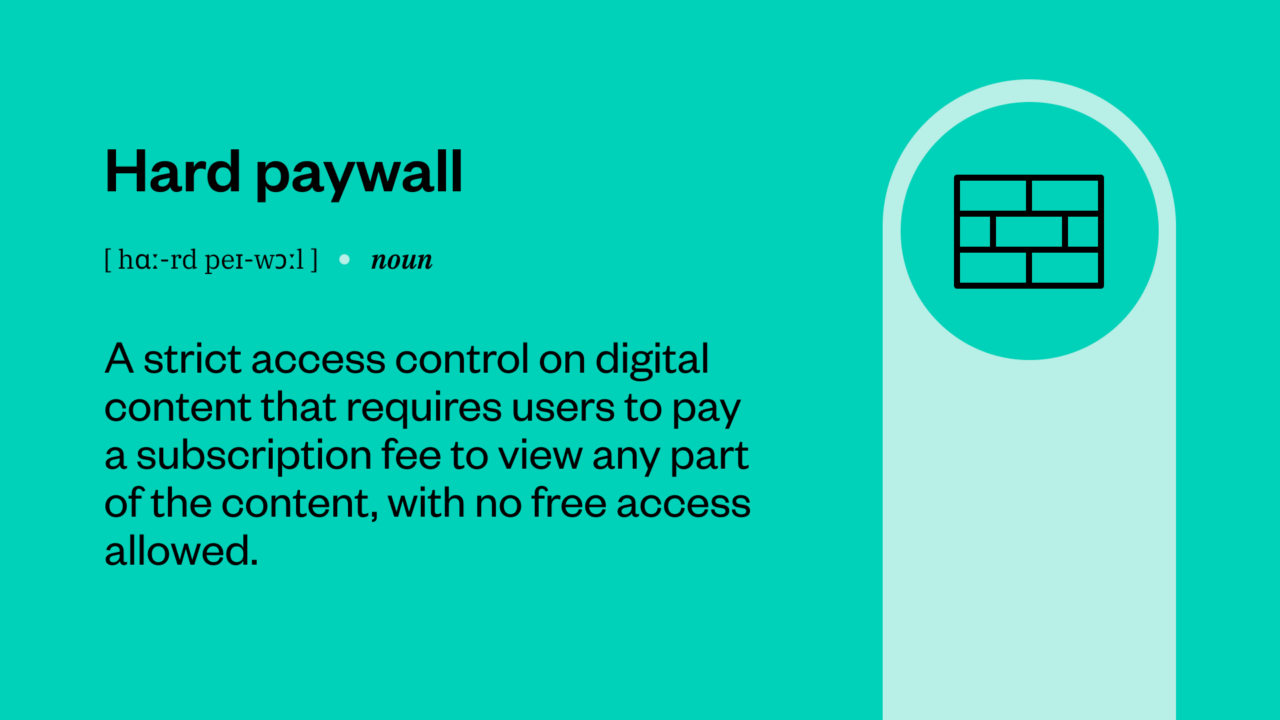Glossary Hub / Hard Paywall: Definition, Implementation, and Strategic Benefits
Hard Paywall: Definition, Implementation, and Strategic Benefits

In an increasingly competitive landscape, fine-tuning your digital strategy is a continual journey necessary to drive growth. When it comes to monetising your content, choosing how you invite casual readers to become paying subscribers is pivotal to attaining high conversion rates.
It can be tempting to lock all your content output behind a paywall because, logically speaking, some might think this would encourage all readers to pay to read. Unfortunately, it’s not as straightforward as that. Hard paywalls can be highly effective for the right kind of digital publisher, but can equally work against you if your brand name alone isn’t enough to drive subscriptions. If you’ve got a strong community, highly-engaged audience and already dominate a particular niche, a hard paywall can be highly effective. This article walks you through the finer details of working with a hard paywall so you can decide whether it’s the right way to go for you.
What is a hard paywall?
Hard paywalls keep your content exclusively accessible to subscribers. Though website visitors may get a small ‘sneak peek’ of your content, they’ll be invited to subscribe to gain unfettered access.
Hard paywalls are straightforward because they establish a definitive binary. If you’re not a subscriber, you won’t be able to access anything. If you are, you can access everything.
Major publications such as The Times, the Financial Times, and The Wall Street Journal (WSJ) all have hard paywalls in place, which goes to show that they do work. That being said, according to a report by the Reuters Institute, only 3% of media outlets opt for hard paywalls, making them the rarest type on the market.

What are the other types of paywall?
To understand the relative advantages and disadvantages of hard paywalls, it’s necessary to understand how they compare to other types of paywalls.
Freemium Paywalls
Freemium paywalls operate with a mix of free and paid content. Essentially, your content offering is segmented, allowing readers to access some parts of your output without subscribing and keeping other parts behind the paywall. Freemium paywalls ride on the possibility that readers hooked on your free content will eventually convert into paying subscriber
Metered or Soft Paywalls
Metered or soft paywalls offer visitors a limited taste of your content before being asked to subscribe. This usually looks like a monthly allowance of ‘free-to-read’ articles. After the reader hits their quota of daily or monthly articles, a paywall is triggered which prevents them from accessing additional content unless they subscribe.
Dynamic Paywalls
Dynamic paywalls are the most ‘intelligent’ and flexible paywall, offering a highly-personalized subscription journey to each user. Dynamic paywalls harness user data to enhance your readers’ specific experience. They do this by using audience segmentation and behavior insights to make tailored adjustments and prime readers for conversion into subscribers.
Is a hard paywall right for my business?
When choosing a paywall structure, remember that there’s no objectively ‘superior’ or ‘more effective’ option. Instead, the best choice for your particular publication will come down to the nature of your output, what your readership looks like, and how established you are in the market.
Hard paywalls target repeat visitors, working most effectively to convert already engaged and loyal readers into paid subscribers. This means that if your publication already has a strong community and highly-engaged audience, and you dominate a particular niche, a hard paywall might make sense.
Advantages of a hard paywall
When leveraged well, you can get a higher lifetime value from your subscribers.
Potential higher conversion rate. If your content is already in heavy demand, a hard paywall might translate to higher conversion rates.
Straightforward and simple. Hard paywalls, once in place, are relatively low maintenance.
Hard to circumvent. Hard paywalls are the most difficult to bypass, which means your gated content will be well-protected.
Disadvantages of a hard paywall
Higher risk of abandonment. If new visitors can’t access your content, they might give up in favour of another publication. This means that without offering the ability to get a taste of the kind of content you’re offering, you may see an increase in your bounce rate.
Harder to attract new readers. If you’re a newer publication or your readership is still growing, the inability to ‘try before you buy’ might discourage new subscriptions.
Not customizable to your readers. Unlike dynamic paywalls, hard paywalls operate with a static, highly inflexible binary that does not take the particular reader’s behaviours or interests into account.
Are hard paywalls a thing of the past?
Nowadays, hard paywalls are a rare species, often overshadowed by hybrid models such as freemium and dynamic paywalls. However, this doesn’t mean that they don’t work. The WSJ, for one, has successfully leveraged a hard paywall strategy since the late 90s, which is a testament to their viability.
The crux of the matter is that paywalls are here to stay. Paywalls have become an integral and necessary part of any digital publisher’s digital strategy, without which you may struggle to stay competitive. That being said, simply implementing a paywall without further thought isn’t enough either. Any successful digital strategy is constantly being refined and reworked, and crucially, is data-driven. So although hard paywalls can work for certain businesses, a more effective and agile method exists in dynamic paywalls. To stay ahead, or even just afloat, consider opting for a flexible strategy that allows you to be creative and learn from your readers.
Leverage AI-powered paywalls
Implementing a hard paywall can be an effective way to drive revenue, but success depends on delivering the right experience to the right user. That’s where AI-powered solutions come in. With Zephr’s AI paywall, you can leverage advanced technology to automatically determine and present the optimal paywall for each visitor—without any manual configuration. Ready to maximize conversions while maintaining a seamless user experience? Explore Zephr’s AI paywall today and take your monetization strategy to the next level!